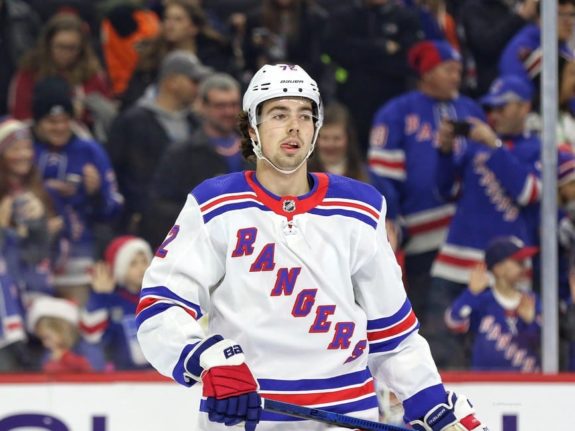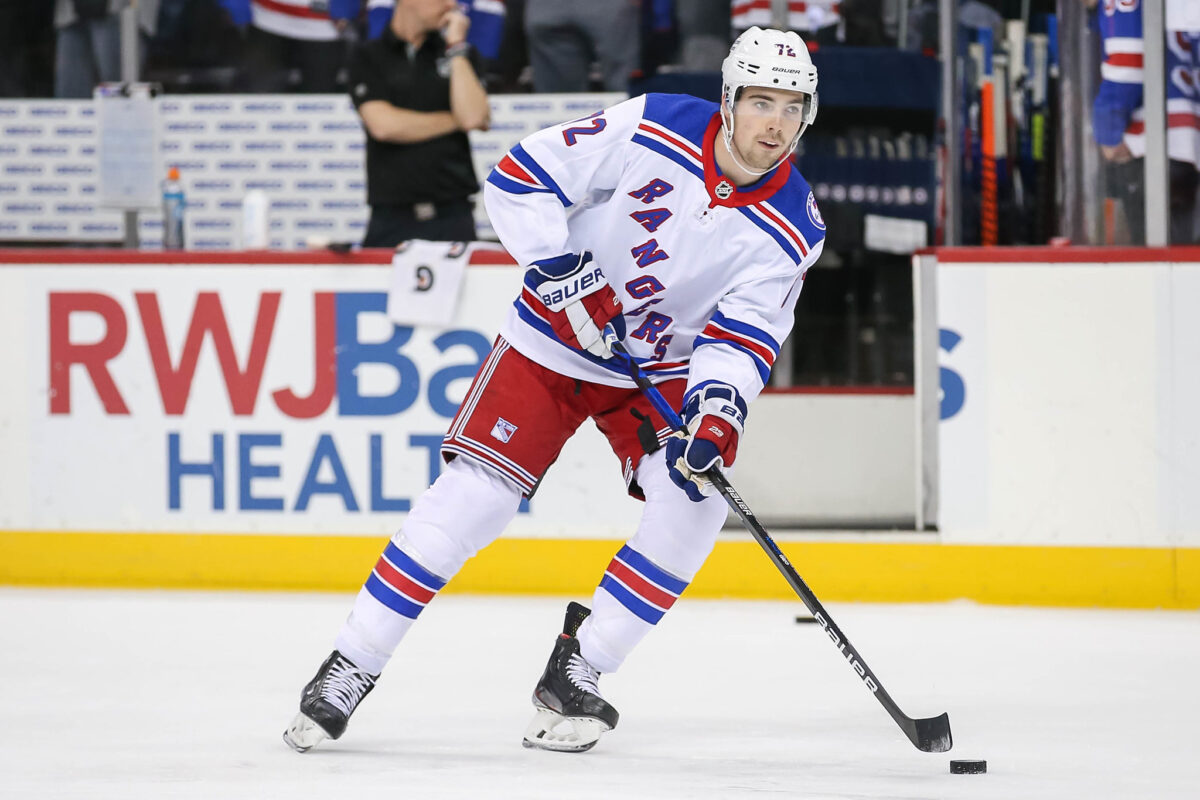Well-rounded centermen are few and far between in the NHL for justifiable reasons — their position requires a lengthy list of job requirements. Yet, any team capable of winning the Stanley Cup has substantial forward depth. The New York Rangers now have an altered center group after Ryan Strome and Kevin Rooney were not offered new contracts from management. The addition of Vincent Trocheck will also change the look of the lines by solidifying the top two center positions.
Mika Zibanejad and Filip Chytil were noticeable centers last season; the former plays in the top-six, while the latter tends to be a bottom-six center. Zibanejad is coming off a career season, while Chytil concluded his 2021-22 campaign a point shy of his career-best.

Tyler Motte, Andrew Copp, Barclay Goodrow, and Johnny Brodzinski all have experience as centers. The club closed out their 2021-22 season with Rooney or Goodrow as the regular centers who shuffled within the last two lines. Now that the Rangers have lost Copp’s services and potentially Motte’s as well, rounding out the bottom two lines is on the front office’s to-do list. And, of course, in the event of injuries, the Rangers need additional center options.
The coaching staff favors the versatility to shuffle lines, yet the team struggled in the faceoff dot last season. One could make the argument that developing a reliable faceoff center should be a priority this season. Management has time to make another acquisition as they get a clearer look at their roster before training camp, but for now, this group will be tested once again to see if they can help lift the team to a Stanley Cup.
Zibanejad & Trocheck’s Numbers
The Rangers’ three-round playoff run in 2022 helped highlight the holes that needed to be addressed. Inconsistencies from veterans, continued faceoff woes, difficulties building onto a lead, and other shortcomings prevented them from advancing to the Stanley Cup Final. Fortunately, Trocheck’s presence should help in a few of those areas.
In the second round, the Rangers faced Trocheck’s former team, the Carolina Hurricanes. In the regular season, he collected 21 goals and 30 assists in 82 games. And during the postseason, he tallied six goals and four assists in 14 games.
Related: Rangers’ Trocheck Signing Likely Seals Chytil’s Fate
Zibanejad, on the other hand, reached a new height in his career — an 81-point season — as he became a point-per-game player with 29 goals and 52 assists in 81 games. What’s even better is that he did not have to sacrifice his offense to contribute defensively and vice versa. That is a sign of a very solid centerman, especially since he performs at this level consistently season after season.
After a look at both players’ statistics, keeping both names at the top would help round out a solid top-six group. Having a distinguished top-six core is something coach Gerard Gallant preferred, especially as we saw in the latter half of the season as he rarely edited the top lines.
Between Zibanejad and Trocheck, the two put up a collective 50 goals and 82 assists for a total of 132 points. To put this in perspective, we can refer to the recent Stanley Cup champions, the Colorado Avalanche. Within the top-six, several forwards swiveled in for the centering role. The significance behind this is that the Rangers do not deploy different centers within the top two lines.
A Glance at a Cup-Winning Team’s Top-Six
Indeed the Rangers should not feel pressured to copy the Avalanche, but that does exhibit how deep the most recent Cup-winning team is. In fact, Nazem Kadri, Mikko Rantanen, and J.T. Compher all slid into a center role during the most important round of the postseason — the Final.
Though in the postseason, it tended to be Nathan MacKinnon or Gabriel Landeskog as the top-line center, the aforementioned forwards slotted in as the 2C, or even MacKinnon and Landeskog would swap their own positions within the top line. It was clear that the team had a ton of talent to be flexible with their lineup.
Regardless, if we look at MacKinnon and Kadri’s combined numbers, since they were the usual regular season 1C-2C punch, this helps gauge where the Rangers are in relation. However, the Rangers differ and excel in certain areas, like goaltending, whereas Colorado has the overall ruggedness and more of the seasoned veteran skill. But if you isolate this specific situation, seeing that both MacKinnon and Kadri collected 175 total points together provides somewhat of a goal for where Zibanejad and Trocheck can aim.
MacKinnon contributed 32 goals and 56 assists for a total of 88 points during the regular season in 65 games. Kadri, on the other hand, racked up 28 goals and 59 assists for 87 points in 71 games. Of course, Trocheck should be given the season to adjust, but it’s likely that with Artemi Panarin as his winger, he should be able to adjust fine.
Now, of course, the Rangers found success with an established 1C/2C setup with Zibanejad and Strome, and it’s more than likely they will take the same approach this upcoming season. Especially as the team was able to be one of three teams left last postseason, the club is not in need of complete reorganization. Perhaps by 2023-23, there is no reason why, barring injuries, Zibanejad and Trocheck cannot reach those numbers of Zibanejad posted with Strome as the 2C.
Chytil & Goodrow’s Numbers
Chytil is much younger than both Zibanejad and Trocheck, and although he has not been in the league as long as his two teammates, he has experienced his fair share of ups and downs. When he seemed to hit his stride in previous seasons, he’d fall victim to untimely injuries, which slowed his development. While Chytil is younger than most of his teammates, his opportunities are running thin, especially as the team is looking to solidify their group down the middle.
Chytil ended 2021-22 on a strong note after he notched seven goals and two assists in 20 postseason games. The Rangers are hoping this translates to 2022-23, as he finished the regular season with eight goals and 14 assists in 67 games, the same total as 2020-21; he reached that pace in only 42 games.
There are still a lot of unknowns regarding the young Czech native with only 253 career games to his name. Of course, after factoring in shortened COVID seasons, the forward has a relatively small sample size for a player who has been in the league for five seasons. However, he has exhibited the qualities of a very solid centerman but has not made the case to earn an elevated role.

Chytil will be relied upon for production in the bottom-six, but his defensive game still needs improvement. Though he is younger than the top-line centers, his two-way game is not as refined. At 6-foot-3, he is one of the bigger players on the team and can really use his size to his advantage. But the truth is he will have another hurdle ahead, as he will likely have new linemates, especially if Gallant promotes their first or second overall draft picks, Alexis Lafrenière and Kaapo Kakko, to top-six roles.
With Goodrow, who can play up and down the lineup, on the wings, or in the middle, the Rangers have a versatile forward. The 29-year-old has Cup experience and a gritty game, which will benefit the bottom-six. He is not a natural center, but Gallant used him there occasionally in the playoffs.
In his first season with the Rangers, Goodrow had the best season of his career. The Toronto native registered 33 points in 79 games — 13 goals and 20 assists. Again, the bottom-six is still undecided, but he would make for a solid center option. He plays a style similar to Trocheck — hard to play again and relentless, bringing that aggression the last two lines need to grind down opponents.
Addressing the Rangers’ Faceoff Situation
Faceoffs are one area where the Rangers continue to struggle. Without Trocheck’s services last season, Zibanejad was the team’s top faceoff man — he won 52.5 percent of his draws. Trocheck ended last season with a 54.6 percent success rate for the Hurricanes, and both players cracked the top 25 in faceoffs in the league (Trocheck at 13th, and Zibanejad at 20th). Last season, Chytil had a 43.3 percent faceoff success rate, and Goodrow won 49.4 percent of his draws, so adding Trocheck should help significantly in the faceoff dot.
With camp coming up in the near future, the coaching staff will have some decisions to make ahead of them. The franchise has enough pieces to allow them to get creative with their lines. They also have a new tool in Trocheck to help their bleak faceoff situation. Of course, there is time for a late acquisition, should the staff feel necessary. Otherwise, this centermen group will need to lead the team to another successful season.